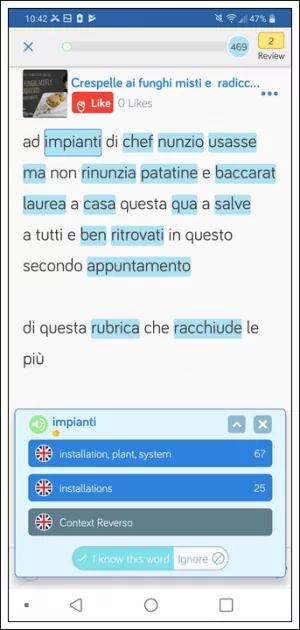Learn Italian Adjectives Faster Using these Examples
Adjectives are a fundamental part of any language, because they allow us to describe more in detail our everyday experience, enriching it with shades of meaning and perception.
But Italian adjectives can be tricky, as they work very differently compared to English ones.
In fact, Italian and Spanish adjectives are quite similar. They both agree in gender and number.
Let me show you, step by step.
What is an adjective
An Italian adjective is used to describe or clarify a noun. Adjectives describe nouns by giving some information about an object’s size, shape, age, colour, origin or material.
“The red car” becomes “La macchina rossa”, for example. Or “La scatola quadrata” (The squared box). We can then combine them to give different information regarding the specific noun: “Il tavolino rotondo nero” (The black round table).
As I mentioned, Italian adjectives agree in gender and number with the nouns they modify. There are two main groups of adjectives: those ending in -o and those ending in -e.
Italian adjectives ending in -o
Adjectives ending in -o in the masculine have four forms according to gender and number:
| Masculine (Maschile) | Feminine (Femminile) | |
| Singular (Singolare) | – o | – a |
| Plural (Plurale) | – i | – e |
| Singular (Singolare) | Il libro giallo (the yellow book) | La scarpa gialla (The yellow shoe) |
| Plural (Plurale) | I libri gialli (The yellow books) | Le scarpe gialle (The yellow shoes) |
Note that when an Italian adjective modifies two nouns of different gender, it keeps its masculine ending. For example: le bambine e bambini grassi (The fat girls and boys).
A few examples of adjectives ending in -o in their masculine singular form:
Allegro (Happy)
Bello (Beautiful)
Brutto (Ugly)
Buono (Good, kind)
Caldo (Hot)
Grasso (Fat)
Magro (Thin)
Noioso (Boring)
Nuovo (New)
Piccolo (Small)
Ricco (Rich)
Vecchio (Old)
Some nationalities end in -o in their base form:
Indiano (Indian), Italiano (Italian), Tedesco (German), Spagnolo (Spanish), Americano (American)
and some colours:
Rosso (Red), Giallo (Yellow), Nero (Black), Grigio (Grey)
Italian adjectives ending in -e
Adjectives ending in -e are a bit easier, as they are the same for the masculine and the feminine singular. In the plural, the -e changes to an -i, whether the noun is masculine or feminine.
Il ragazzo felice > I ragazzi felici
La ragazza felice > Le ragazze felici
A few examples of adjectives ending in -e in their masculine singular form:
Difficile (Difficult, hard)
Divertente (Funny)
Dolce (Sweet)
Facile (Easy)
Felice (Happy)
Gentile (Kind)
Giovane (Young)
Grande (Big)
Forte (Strong)
Naturale (Natural)
Piccante (Spicy)
Veloce (Fast)
Verde (Green)
Adjectives’ position
Unlike English, adjectives in Italian generally go after the noun:
La macchina rossa (The red car)
L’uccellino giallo (The yellow bird)
La pera verde (The green pear)
La ragazza antipatica (The mean girl)
Il ragazzo gentile (The kind boy)
Also, there is no rigid order but we can find a general guideline as follows:
1) Functional adjectives: quality – size – time – shape – colour
2) Noun
3) Descriptive adjectives: colour – shape – time – size – quality
E.g. Un bel vaso cinese (A nice chinese vase)
Una vecchia scarpa rossa (An old red shoe)
Una grossa mela marcia (A big rotten apple)
The meaning of some adjectives can change depending on whether they come before or after the noun.
Un mio vecchio amico = an old (meaning long-standing) friend of mine
Un mio amico vecchio = an old (as in of old age) friend of mine
In the case of possessive adjectives, meanings stay the same even when their positions in the sentence change.
“Andiamo a casa mia” (Let’s go to my house)
“La mia casa e’molto vecchia.” (My house is really old)
Learn Italian faster, using content you love
We both know that remembering grammar rules and how adjectives work can be a bit tedious. Afterall, learning a new language takes time, trying to remember rules on top of that may be asking too much.
That’s why I recommend LingQ to learn Italian online. Simply put, LingQ comes equipped with 100s of lessons that have been transcribed and recorded by native Italian speakers. They’re easy to read and follow thanks to LingQ’s interface which also allows you to look up words with a single tap!

Not only does LingQ come equipped with loads of content, but also, you can import Italian content you enjoy into the app too! Turn your favorite Italian YouTuber videos, audiobooks, and much more into interactive lessons.
Try it for free today, LingQ’s language learning apps are available for both Android and iOS. Good luck!
***
Giulia was born in Italy and currently lives in Scotland. She works as an English and French translator and as a teacher.


